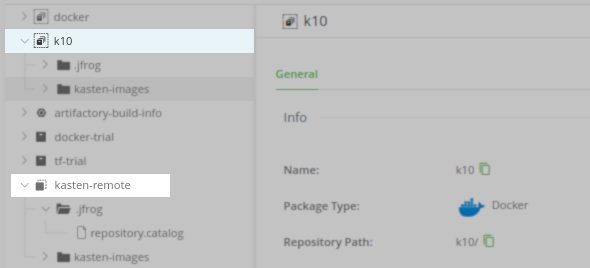
How to Configure an Air-Gapped Veeam Kasten for Kubernetes Deployment Using JFrog Artifactory
AI Score
Confidence
High
Purpose
This article provides a step-by-step approach to configuring a JFrog Artifactory server and installing Veeam Kasten for Kubernetes. This allows for creating an air-gapped installation using a private container registry to install Veeam Kasten for Kubernetes. While this can always be done manually, the k10offline tool makes it easier to automate the process.
Solution
- After logging into the JFrog dashboard, select Repositories menu from the sidepanel.

-
Create a new Remote Repository.
Package Type: Docker
Repository Key: <user defined> #e.g. kasten-remote
URL: https://public.ecr.aws/
Include Patterns:
kasten-images
kasten-images/**/*

-
Create a new Remote Repository.
Repository Key: <user defined> #e.g. k10
Selected Repositories: <add the remote repository created in the previous step from the available repositories list>

In the Advanced tab –> select “Artifactory Requests Can Retrieve Remote Artifacts”

- Prep helm to pull the new image and capture the latest Veeam Kasten for Kubernetes release.
This will update the repositories helm knows about and make sure that all of the latest references are there. The latest version of Veeam Kasten for Kubernetes is being captured in a variable to be used in consecutive commands.
Note
Since Helm v2 has been deprecated, it’s recommended to use Helm v3.
All of the commands below are utilizing v3.
helm repo update
export K10_VER=$(helm search repo "k10" -o yaml | head -1 | awk '{print $3}')
Copy
- Pull an image from your configured Artifactory repository.
Pulling an image from the configured Artifactory will fetch that image from the upstream kasten registry and cache it into Artifactory. If everything is connected correctly, then this command will be successful.
Note
If authorization is required for the Artifactory, one must log in before pulling images from it.
docker login <artifactory_registry_hostname>
docker pull <artifactory_registry_hostname>/<artifactory_virtual_repository_key>/kasten-images/k10offline:"$K10_VER"
Copy
- Go to the Applications card and verify artifacts under both Virtual andRemote repositories.

- Fetch the Helm chart for Local Use
helm fetch kasten/k10
Copy
- If the private repository (repo.example.com) has downloaded K10 charts and images from the remote repository, an air-gapped installation can be performed by setting global.airgapped.repository=repo.example.com (shown below)
helm install k10-"$K10_VER".tgz --name k10 --namespace kasten-io \ --set global.airgapped.repository=repo.example.com
Copy
- There are other ways to use a private repository.
To pull K10 charts and images locally and subsequently upload them to the private repository manually, review Preparing K10 Container Images for Air-Gapped Use.
Note
K10 helm chart and container images are available at:
-
gcr.io/kasten-images/
_(preferred, general usage) _
-
public.ecr.aws/kasten-images/
(if required to white list external domains)
- To view images on a browser, visit the AWS Gallery - Veeam Kasten for Kubernetes.
To submit feedback regarding this article, please click this link: Send Article Feedback
To report a typo on this page, highlight the typo with your mouse and press CTRL + Enter.
AI Score
Confidence
High